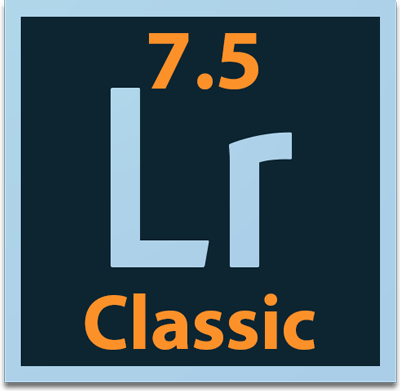 Adobe today released Lightroom Classic CC 7.5, with new Book module features, Windows support for Apple HEIC files, support for new cameras, new lens profiles, bug fixes and more. (Updates were also released for the cloud-based Lightroom CC desktop application as well as for Lightroom CC mobile (iOS and Android) – see my Lightroom CC article for information on this.)
Adobe today released Lightroom Classic CC 7.5, with new Book module features, Windows support for Apple HEIC files, support for new cameras, new lens profiles, bug fixes and more. (Updates were also released for the cloud-based Lightroom CC desktop application as well as for Lightroom CC mobile (iOS and Android) – see my Lightroom CC article for information on this.)
Note that there is no update to, and there will not be any more updates to, the non-subscription Lightroom 6 application – the last update was Lightroom 6.14, released in December, 2017.
In This Article:
Whether and How to Update
While I don’t have any indication that things won’t go smoothly, it’s not a bad idea to wait a week or two before updating to 7.5 to see if others experience issues, unless you need the update urgently. If I hear of serious issues with this release I will post them here in this section – please check here rather than emailing me. You can check for reported issues and/or report your own issues on the Adobe Lightroom Classic bug and feedback site.
UPDATE August 27, 2018: What I’m seeing when I review the Adobe Lightroom Classic bug and feedback site is that:
- Some people are having trouble dragging photos to the map in the Map module – either the position is offset, or it doesn’t work.
- If you were seeing slow imports before, it hasn’t been resolved in this release.
- Legacy Adobe presets aren’t showing in the Presets panel. This isn’t a bug – they are now hidden by default. Here’s an article from Victoria Bampton on how to display them.
- Confusion over why presets that include a profile sometimes show in the Presets panel and sometimes don’t.
Given this I would say that it’s generally safe to update (though there will always be someone somewhere who has a problem.) If you use the Map module and experience the Map issue above, you can revert to Lightroom Classic 7.4.
 To update to Lightroom Classic 7.5, go to Help>Updates, and in the CC app that opens, click on Update next to “Lightroom Classic CC” (NOT Lightroom CC or Lightroom CC 2015.) If the update is not listed in the CC app, click on the three dots in the top right and choose Check for App Updates. If it’s still not there and it’s the day of release, then try later. Otherwise try signing out and signing in again. Read here to learn how, in the CC app, to display only apps you use.
To update to Lightroom Classic 7.5, go to Help>Updates, and in the CC app that opens, click on Update next to “Lightroom Classic CC” (NOT Lightroom CC or Lightroom CC 2015.) If the update is not listed in the CC app, click on the three dots in the top right and choose Check for App Updates. If it’s still not there and it’s the day of release, then try later. Otherwise try signing out and signing in again. Read here to learn how, in the CC app, to display only apps you use.
Book Module Enhancements
With Lightroom’s Book module you can design photo books that you can have published by Blurb.com and PDFs and JPEGs that you can share electronically. New in Lightroom Classic CC 7.5 you can:
- Choose new less-expensive magazine and trade book options
- Layout photos and text free-form on a page (hooray!)
- Add borders of any width and color to one or more photos
- Choose to add page numbers to just left or just right pages (or both as before)
- Pause and resume upload to Blurb.com.
Watch my video tutorial below for full details on all of these enhancements, or read on below the video.
For best quality, after hitting Play click on the sprocket wheel in the bottom right and choose 720/HD.
To learn the Book module in depth, get my Lightroom CC/6 and 5: Producing Great Output video series! I spend three hours on the Book module, and I also cover Print, Slideshow, Web, and important output concepts that every photographer should learn. Despite the title, it is applicable to Lightroom Classic CC v. 7 (as well as Lightroom 5, 6 and CC 2015), and soon 2018 purchasers will receive downloadable updates for the new features added today.Lay Out Photos and Text Free-Form on a Page
Start your page design with any page format, and then modify from there:
- Photo cells now have square handles on the edges – drag on these to resize the cell. (Dragging elsewhere on the edge will adjust cell padding, as before.) Note that the handles are at the edges of the cell, not the photo – you’ll notice the difference if you have Zoom to Fit on so that none of your photo gets cropped off.

- To move a cell elsewhere on the page, drag on the center square – see screenshot above. (Dragging elsewhere inside the photo will move the photo within the cell if it is zoomed in, or it will do nothing if zoomed to fit.)
- To make small changes in cell position, select the cell, then hold down Alt/Opt and use your arrow keys.
- Turn on Guide Lines in the Guides panel to aid in lining up photos with other cells. Turning on the Page Grid can also help. There’s currently no option to snap to grid or cells, and no option to duplicate a cell. Remember that you can zoom in with the Preview panel!
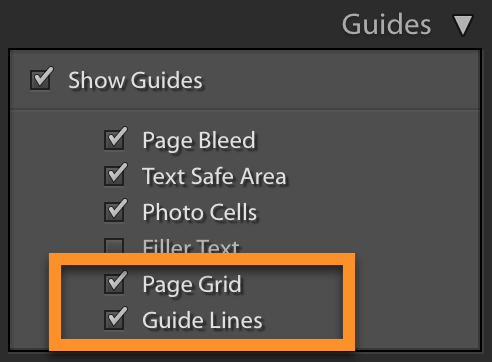
- To add a new cell, select the page, then right-click and choose Add Cell > Photo Cell.
- If your photos overlap, to change the order displayed from top to bottom, right-click in the selected cell and choose Send to Back or Bring to Front.
- Add text anywhere on the page with the new Photo Description field: right-click on the page, choose Cell>Photo Description, and then type in your text. Resize and move the Photo Description cell as desired.
- As before, you can save your page layout for use elsewhere in your current book and in future books: right-click on the page and choose Save Custom Page. You’ll find it in a Custom Pages section in the page formats list in the Page panel.
Less Expensive Book and Magazine Formats
In the Books Settings panel, you can now choose to make a Blurb photo book, which was available in earlier versions as “Blurb”, or one of the new formats: a Blurb trade book or a Blurb magazine.
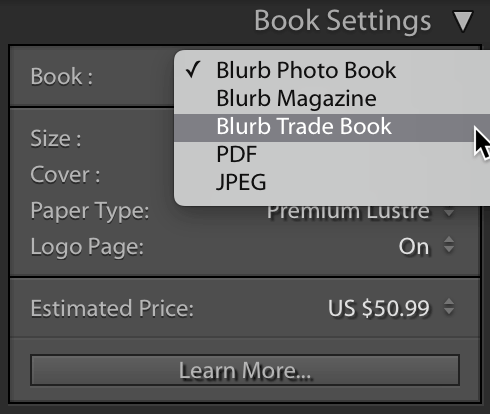
As before, Blurb photo books are printed on your choice of several premium photo papers. However, they are expensive – sometimes prohibitively so if your goal is to sell your books. Trade books are substantially less expensive, as are magazines. Read more about these book formats on the Blurb website. With trade books you can choose from one of three sizes starting at 5″x8″, as well as hardcover or softcover. Note that the website lists two paper types – standard and economy. Lightroom will use standard.
My impressions of trade book and magazine quality: I ordered and received a swatch kit with the photo book, trade book and magazine papers, with printed photos and text on them. The magazine quality is comparable to photo book quality – very good. Trade book quality is not as good – there is more washout of color and contrast. Nevertheless, trade book prices are much lower than photo book prices. Do order a swatch kit before making your decision. For advanced users, Blurb has a printer profile for their photo books, that you can soft proof with in Photoshop. There is not one for trade books, as print quality is not consistent enough to be represented by a single profile.
Photo Book Layflat Option
For Blurb photo books, you can now choose Blurb’s LayFlat option. This option is very expensive, but it’s great to be able to have your book open and have the pages lay flat.
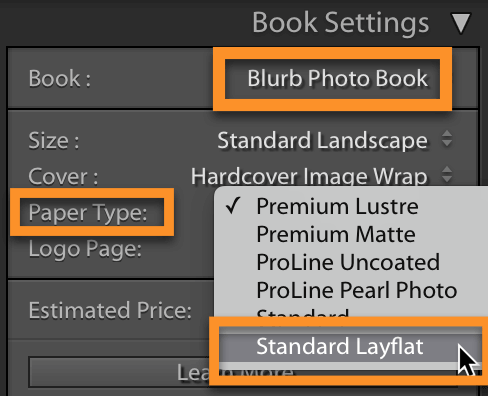
Page Limits
Here are the maximum number of pages by book type:
- Photo book with Standard paper: 440
- Photo book with Layflat paper: 110
- Photo book with any other paper type: 240
- Trade book: 480
- Magazine: 240
- PDFs, JPEGs: 480
Add Photo Borders
To add a photo border, select one or more photo cells (or to select all, go to Edit>Select All Photo Cells), then in the Cell panel, check “Photo Border Color”. Change the width with the Width slider; change color by clicking on the color square. Note that you won’t see the border if your photos go to the edges of the page!

The border will be on the edges of the photo cell. If you want it to be on the edges of your photo, either resize the cell to be the same size as the photo, or right-click on the photo and choose Zoom to Fill to have the photo fill the cell. (This will crop off part of your photo. Drag in the photo, but not on the square handle in the center, to reposition the photo in the cell.)
New Page Number Options
Now choose to have page numbers printed on just lefthand pages or just righthand pages rather than on both:
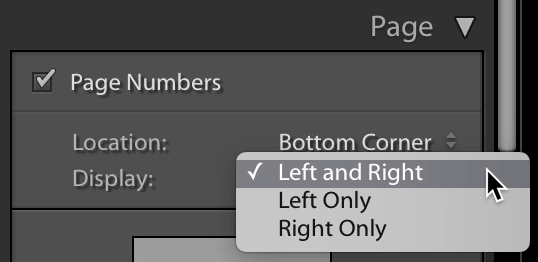
Pause and Resume Book Uploads
After starting your book upload, to pause or resume it, click on the identity plate (logo area) in the top left and hit the Pause/Play button. Note that if you close Lightroom the upload will be cancelled, as before.
Import Preset and Profile Zip Files
Now directly import presets and profiles that are bundled in a zip file (i.e. without having to unzip the file).
For presets, click on the + at the top right of the Presets panel, choose Import Presets, select the zip file and click on OK.
For profiles, open the Profile Browser, click on the + at the top left, choose Import Profiles, select the zip file and click on OK.
This will work for XMP presets and profiles, as well as DCP and LCP profiles. It will not work with .lrtemplate files bundled into a zip file.
Facebook Collections Available
If you used the Facebook publish service, you most likely know that it’s been discontinued, due to restrictions by Facebook. The last Lightroom Classic update removed the publish service, which took away your access to the collections of photos you had published. Now in Classic 7.5 Adobe has made these collections visible again in the Publish Services panel so that you can convert them to regular collections. Either do this manually, or use John Beardsworth’s script to convert them automatically. Don’t wait!
HEIC/HEIF File Support
The new default image type when shooting with an iPhone camera is HEIC/HEIF. Lightroom Classic 7.4 added support for importing and editing these files on Mac OS High Sierra (10.13.x), and Classic 7.5 adds support on Windows.
HEIV/HEVC video files are not yet supported by Lightroom on any operating system.
New Camera Support
Raw files from the following new cameras can now be imported:
- Parrot Anafi
- Sony DSC-RX100M5A
- Sony DSC-RX100M6
Click here to see a list of all cameras supported in each version of Lightroom (and Camera Raw).
New Lens Profiles
Bugs Fixed
Adobe publishes news about bug fixes for customer-reported issues only. Many other bugs are fixed with each release, so if you don’t see an issue you’ve experienced in the list below, there’s still a possibility that it has been fixed. Report new bugs here.
Customer Reported Bugs Fixed
- Right-click to create a new collection defaulted to the wrong collection set
- Touch workspace appears broken (thumbnails missing)
- Preset incorrectly disables Lens Correction
- Preset works all the time with raw files but only some of the time with a JPG file
- Export using percentage results in wrong dimensions
- Crop/Transform overlays are hard to see on lighter images
- Imported movie file is saved to a different folder from capture date and time
- Dehaze tool causes lag in Develop sliders
- Unable to read multiple metadata fields in CR3 files
- GPU rendering will not complete in Develop mode at Fit/Fill zoom levels
- Replacing an existing preset doesn’t work
Related Content
